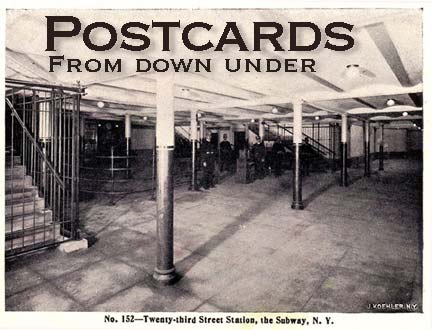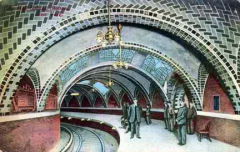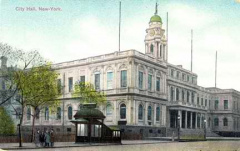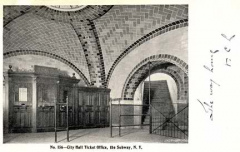AS MANY Forgotten fans know, what attracts me to the subway is its iconography and signage that preserve styles from decades past; look in any Forgotten NY subway page devoted to old signage, and you will see that the MTA has unwittingly left a museum under its nose; despite its best efforts to standardize things, the old stuff…and a lot of it…is still down there.Though the NYC subway was not the world’s first…there were others in London and Boston years before construction began here…it was immediately recognized as a tourist attraction.

The subway on opening day, October 27, 1904
Such was its novelty that at first, the subway was a destination in itself; it eventually freed the streets from the noise and tumult of the elevated. Its first stations were constructed under the aegis of Chief Engineer William Barclay Parsons by the firm of George Heins and Christopher LaFarge. In the early 1900s, architecture was in the sway of both the Beaux-Arts and Arts and Crafts movements, which would play a big hand in the subways’ early days. Beaux-Arts lent its ornate decoration to the early stations, while Arts and Crafts was in many ways responsible for subways leaning on mosaic, marble, brick, ceramics and colorful terra cotta.
Though NYC has potentially the world’s most beautiful subway, the beauty has been compromised in a myriad of ways. Water damage; the wear and tear of a clientele numbering in the millions; neglect and apathy; the predations of graffitists and other criminals…they all conspired to send the NYC subway to near collapse. Thankfully, the ascension to power of a wiser manangement that recognized the NYC subway’s uniqueness and worth was able to pull it back from the brink. Today service is as good as it has been in decades, and subway stations have been restored to original glory, though some still languish in their 1980s decrepitude.
In the subways’ early days, postcard manufacturers such as J. Koehler, Underwood and Underwood, Blanchard Press, and others issued images of the subway in its inagural era; the original Interborough Rapid Transit (at first in only one borough) ran from City Hall north, west and north again to west 145th Street. Forgotten NY is proud to present, in the subway’s 100th year of operation, a small number of images from the collection of Ed Levine, who is writing an article about them in Postcard Collector magazine in the November 2004 issue.
City Hall is unique among all NYC subway stations in its layout and use of color in decoration. It stands under the left side of City Hall as you face north, just east of Broadway and Murray Street. It featured chandeliers, alternating dark and light green tile created by the Guastavino Fireproof Construction Company, whose tiles also grace the Oyster Bar in Grand Central Terminal, the NYC Municipal Building, the Cathedral of St. John the Divine, and the Bronx Zoo Elephant House; the Guastavinos, Rafael Sr. and Jr., from Barcelona, Spain, often fashioned their tiles with criss cross designs that helped to impart a spacial effect in an otherwise crowded or cramped area. 3 skylights, blackened during World War II, allowed natural sun to filter in.
City Hall has never had turnstiles; although stiles were first installed in other stations beginning in the 1920s, City Hall never had them at all until it closed in 1945; tickets were purchased in its wooden ticket booth and placed in a ticket chopper.

Despite a halfhearted restoration in 1996 in which its original plaques were reinstalled after years at the nearby Brooklyn Bridge station, as you can see, an original brilliantly colored aqua, gold and white nameplate has been compromised. In the past, City Hall has been proposed as a branch of the Transit Museum, but its unlucky position under the seat of NYC government means it will forever be closed due to terrorism fears; at this writing (8/04) no events are even planned for it in 2004, the year of the subway centennial. FNY was lucky enough to enter during one of the last Transit Museum-sponsored tours in 1998, snapping an R36 “redbird” looping through the station on its way uptown. The City Hall station, and the redbirds, have died a death.
Joe Brennan’s City Hall page
nycsubway.org City Hall page (including more postcard images)
Saul Blumenthal’s City Hall page
Guastavino tiling
Roger Shepherd’s decorative terra cotta tiling page
Parts of the 14th Street station are no longer in use. 14th Street, an unusual station that twists and turns under Union Square, a topography that requires the platform to use gap fillers similar to those used in the South Ferry station (after renovations are complete at South Ferry by the end of the 2000s, those fillers will be removed, leaving 14th Street as the only station that uses them).
This postcard must have been produced after 1910; after that year, the 14th Street express platforms were lengthened, and the side platforms, in use for local trains, were abandoned and covered up with columns and tiles, explaining the lack of decoration or nameplates. Unlike other renovations, those platforms weren’tremoved, though. The side walls were originally graced by ceramic eagles likely produced by William Grueby’s Grueby Faience company. Some of the eagles were removed and placed in the mezzanine running above the 14th St. station leading to the exit on the south side of 14th Street.
Joe Brennan’s 14th Street page
Saul Blumenthal’s 14th Street page
nycsubway.org 14th Street page
Oddly, the photos I’ve seen of the ticket booth of the 18th Street station show a clock, a feature I haven’t seen at any of the other original stations, though it’s possible clocks were at every ticket booth…it’s quite likely.
When the subway extended IRT platforms after World War II, it was considered redundant to do so here, since it would bring the station’s platforms quite close to 14th Street or 23rd Street. It was therefore abandoned in 1948. It’s still there in Beaux-Arts splendor, though, and is awaiting renovation. Perhaps a restaurateur or furniture showroom can go in there?
Brennan’s 18th Street page
Blumenthal’s 18th street page
nycsubway.org’s 18th Street page
The 23rd Street and 28th Street stations on the IRT Lexington present something of a mystery for me. Photographs of them when they were new, as seem here, show a staircase and a more-or less two-level platform, but I don’t recall the staircase being there now. What happened to it?
This is the same view as above left, but with passengers painted in. For 1905, the station strikes me as exuberantly streamlined and modern, with skylights allowing ample sunlight. This principle will be carried forth in new transit hubs being designed in lower Manhattan at Fulton Street and Church Street.
Note the paint scheme on the pillars:they were cream white with maroon and dark green. The scheme has been preserved at the IRT Astor Place station.
From the very beginning, 23rd Street was designed with storefronts near the downtown platforms. As can be seen in these 1999 photographs, the stores have been long abandoned; they were used as an entrance for a Woolworth’s above the platform. A similar arrangement persists at Astor Place, where an original entrance to Wanamaker’s now allows entrance to KMart.
There used to be massive cast iron kiosks, like this pair at 28th Street and Park Avenue South, at every IRT station, marked “entrance” and “exit”; the designs were distinct, with “entrances” having a rounded top and “exits” being pointed. Most of these survived until the early 1960s, but were then demolished because it was thought they interrupted drivers’ sight lines; they did take up a lot of sidewalk real estate. The MTA has built a couple of new ones to the old specs above the IRT Astor Place station and Borough Hall station on Court and Montague Streets in Brooklyn Heights.
In addition to station scenes, novelty cards like these were also produced in the very early days of the NYC subway.
On this page we’ve just skimmed the surface of Ed Levine’s subway postcard collection. David Pirrmann has posted the bulk of the collection on various IRT pages in nycsubway.org!
8/7/04



